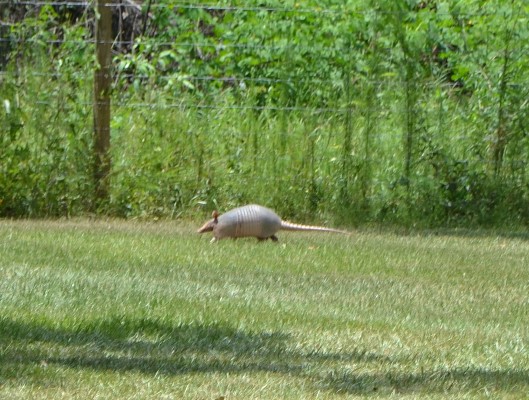
by Les Harrison | Mar 9, 2018
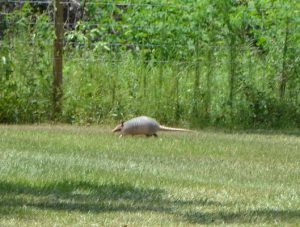
The common nine banded armadillo scurrying across the lawn.
Photo: Les Harrison
The first light of morning can reveal random pockmarks in what had been the perfect lawn the previous evening. The culprit is not likely the neighborhood teenager with a reputation for inappropriate practical jokes.
The offender usually is the nine-banded armadillo, sometimes referred to as a Florida-speed-bump or Possum-on-the-half-shell. In addition to manicured landscapes, they also encroach in natural areas and destroy sensitive habitats.
Armadillos eat adult insects and larvae, but also quail and turtle eggs. They incessantly dig holes in their search for food, many times uprooting plants in their food search. Their foraging holes are approximately one to three inches deep and three to five inches wide.
Using insecticides in landscapes to decrease the armadillo food supply is not guaranteed, but may help reduce the digging. In cases where there is a large, and always ravenous, armadillo population this reduction of food may increase digging activity as they search more diligently for a smaller food supply.
Another consideration is all chemical treatments have to be reapplied on a permanent basis for long term control. Always read and follow label instructions for safe use of insecticides.
Armadillos rest in a deep burrow during the day and are usually active after dark. Burrows openings are approximately seven to eight inches in diameter, about the size of a one-gallon plastic jug, and up to 15 feet in length.
This exotic invasive may burrow under driveways, foundations and patios potentially causing structural damage. Additionally, their burrows in pastures pose a potential leg-injury hazard to large wildlife and livestock.
Several live-trapping techniques can be used to capture armadillos as they exit of their burrows. Because armadillos are nocturnal, trapping techniques designed to capture them as they emerge from their burrows should be applied late in the afternoon and checked several hours after darkness.
Fencing is another option to discourage the presence of armadillos. Relocating captured animals is illegal and not recommended because it only transfers the problem elsewhere and can spread this problem species.
Fossil records indicate the armadillo’s ancestors were as large as modern-day rhinos. One can only imagine what front yards would look like if they still existed.
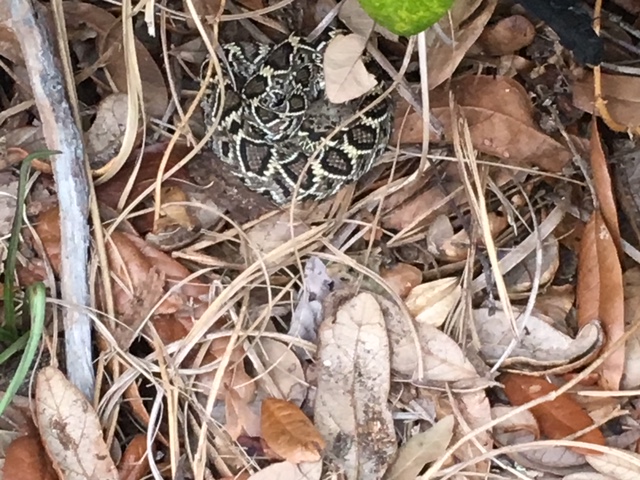
by Rick O'Connor | Mar 9, 2018
Most people know that snakes are ectothermic and the environment is what regulates their body temperature. However, many do not know that they like to maintain their temperature close to 98 F like us. To do this they must move to locations where they can either warm (like basking in the sun or lying on warm asphalt) or cool (like under rocks or logs). Unlike us, their temperature can rise to above 100 F or down close to 30 F with few health problems.
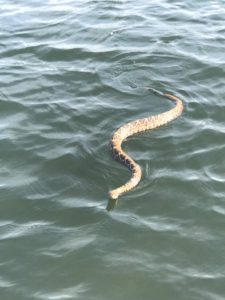
Eastern Diamondback Rattlesnake swimming across the Intracoastal Waterway near Pensacola Beach.
Photo: Andy Barnes
When environmental temperatures become colder, their heart and breathing rates slow significantly. Their blood oxygen levels decrease, and they become very slow and sluggish – a condition we call torpor. There are some advantages to this, such as not having to hunt for food for several weeks or months, but when the air temperatures begin to climb they become more active… Moreover, their hungry.
In the last two weeks, I have had numerous reports of snakes moving around in yards. There have been three records of diamondback rattlesnakes in the Pensacola Beach area alone.
Should I be concerned about doing outdoor activities?
No, not really – but you should be aware. As it warms, snakes will become more active early in the morning and late in the evening. Pit vipers, like rattlesnakes and cottonmouths, actually prefer hunting at night. However, when the temperatures are cool enough for mid-day movement, they will. Food and reproduction (for some species) are on their mind this time of year.
Stay on the trails – snakes typically do not like to be in the open because of predators but they do have to bask to increase their body metabolism; so they may be along the edge. If I am hiking, I tend to look down along the trail when walking. If I want to observe something in the trees, I stop.
These snake movements happen every year, and very people have problems, but with the recent increase in encounters it is could to be aware. I actually think snakes are pretty cool. I enjoy seeing them, especially ones that are not viewed very often like coral snakes and rattlesnakes. You should still go out and enjoy the Pensacola Bay area. It is a great time of year to do it.

by Laura Tiu | Mar 9, 2018
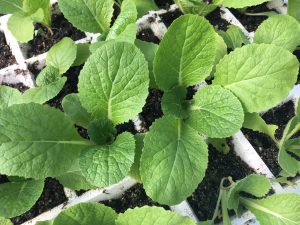
Aquaponic Napa cabbage
There is growing interest in hobby-scale farming techniques. In response to this need, UF/IFAS Walton County Extension Office established a hobby farm featuring a variety of low-input food production options. The farm is a cooperative venture drawing on expertise of the Horticulture, Aquaculture/Marine Science, 4-H, and Agriculture programs. The farm is on a relatively small, tenth acre, plot behind the County Extension Office where staff and volunteers have installed aquaponics and hydroponics systems, honeybee boxes, a chicken coop as part of the 4-H Chick Chain Program, herb garden, raised vegetable bed system, sustainable citrus grove, muscadine grape trellis, shiitake mushroom structure, and blueberry orchard.
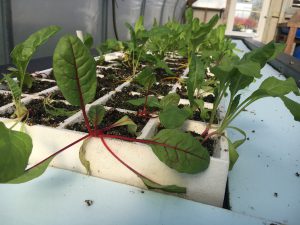
Aquaponic Swiss chard
The aquaponics demonstration system was constructed in 2017 using materials purchased at local stores, Tractor Supply Company and Lowes, or on Amazon.com. The system has a 300 gallon Rubbermaid fish tank that gravity feeds into a 20 gallon plastic garbage can with lid stuffed with bird netting for solids removal and biofiltration. The water then feeds into two 2 ft. x 8 ft. feed troughs with approximately 2 square yards of floating Styrofoam grow beds. Finally the water drains into a 100-gallon sump where it is pumped back into the fish tank. A small air pump provides supplemental air to the fish tank and a small water heater helped maintain temperatures during the winter.
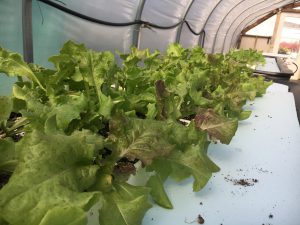
Aquaponic red lettuce
The fish tank is stocked with 18 catfish, originally 4-5 inches, now approximately 10-12 inches, and pushing a half-pound each. The system produced two crops of red and romaine lettuce during the last half of 2017 and is currently planted with romaine and red lettuce, Swiss chard and Napa cabbage. Lettuce is harvested out of the system every five to six weeks, while Swiss chard and Napa cabbage a take longer to reach harvest size.
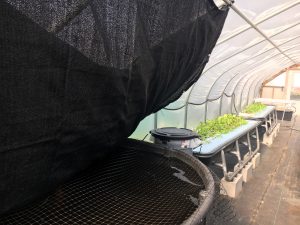
Walton County demonstration aquaponics system.
There is a lot of aquaponics information available on-line. Academic institutions and other research-based organizations are the best places to look for information. The University of Florida has a comprehensive factsheet entitled “A Practical Guide for Aquaponics as an Alternative Enterprise” available at http://edis.ifas.ufl.edu/hs1252. Also recommended is the Food and Agriculture Organization “Small-scale Aquaponic Food Production” manual available at http://www.fao.org/3/a-i4021e.pd.
Aquaponic seminars or webinars are conducted upon request and provide introductory information on a variety of system designs and stocking options. Over 400 visitors have seen the aquaponics and other hobby-scale gardening demonstration plots over the past year, gaining knowledge and acquiring skills to use in their own gardens. If you are interested in a signing up for the aquaponics email listserv, participating in a tour, having a personal consultation or attending a workshop, please contact Laura Tiu, lgtiu@ufl.edu.

by Carrie Stevenson | Mar 2, 2018
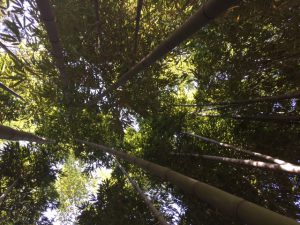
Bamboo shoots. Photo credit: Carrie Stevenson
Standing in the midst of a stand of bamboo, it’s easy to feel dwarfed. Smooth and sturdy, the hollow, sectioned woody shoots of this fascinating plant can tower as tall as 70 feet. Unfortunately, bamboo is a real threat to natural ecosystems, moving quickly through wooded areas, wetlands, and neighborhoods, taking out native species as it goes.
We do have one native species referred to as bamboo or cane (Arundinaria gigantea), which is found in reasonable numbers in southeastern wetlands and the banks of rivers. There are over a thousand species of true bamboo, but chief among the invasive varieties that give us trouble is Golden Bamboo (Phyllostachys aurea). Grown in its native Southeast Asia as a food source, building material, or for fishing rods, bamboo is also well known as the primary diet (99%) of the giant panda. In the United States, the plant was brought in as an ornamental—a fast growing vegetative screen that can also be used as flooring material or food. Clumping bamboos can be managed in a landscape, but the invasive, spreading bamboo will grow aggressively via roots and an extensive network of underground rhizomes that might extend more than 100 feet from their origin.
As a perennial grass, bamboo grows straight up, quickly, and can withstand occasional cutting and mowing without impacts to its overall health. However, a repeated program of intensive mowing, as often as you’d mow a lawn and over several years, will be needed to keep the plant under control. Small patches can be dug up, and there has been some success with containing the rhizomes by installing an underground “wall” of wood, plastic, or metal 18” into the soil around a section of bamboo.
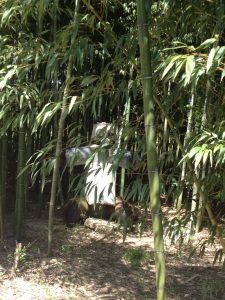
Whimsy art Panda in a bamboo forest at the Glendale Nature Preserve. Photo credit: Carrie Stevenson
While there are currently no chemical methods of control specifically labeled for bamboo at this time, the herbicides imazapyr (trade name Arsenal and others) or glyphosate (Round-up, Rodeo) applied at high rates can control it. According to research on the topic, “bamboo should be mowed or chopped and allowed to regrow to a height of approximately 3 feet, or until the leaves expand. Glyphosate at a 5% solution or imazapyr as a 1% solution can then be applied directly to the leaves.” These treatments will often need to be repeated as many as four times before succeeding in complete control of bamboo.
Land managers should know that while imazapyr is typically a more effective herbicide for bamboo, it can kill surrounding beneficial trees and shrubs due to its persistence in the contiguous roots and soil. In contrast, glyphosate solutions will only kill the species to which it has been applied and is the best choice for most areas managed by homeowners.
Bamboo Control: http://edis.ifas.ufl.edu/pdffiles/AG/AG26600.pdf

by Sheila Dunning | Mar 2, 2018
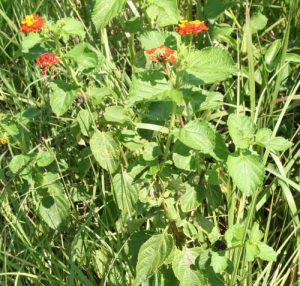
Lantana is a landscape plant that easily escapes cultivation and spreads. Photo Credit: Jennifer Bearden
You know that plant in the corner of the yard that seems to be taking over? It’s the one that your friend “passed along” because they had plenty of them and wanted to share. After all, it grows so well. How can you go wrong?
The odds are that vigorous plant is a non-native species. The majority of what is sold in nurseries are introduced from a foreign country and developed for their uniqueness. The problem is that many of the plants brought into the United States arrive without their natural enemies. Under the long, warm growing season found in Florida, these non-native plants become the dominant plant in an area and manage to out-compete the native plants. When this happens, these introduced plants get labeled as an “invasive species”.
These invasive species threaten Florida’s environment, economy and health, requiring an estimated $120 billion a year to control them. Learning which of these plants have the potential to become invasive has been a focus of researchers with the UF/IFAS Center for Aquatic and Invasive Plants. They have spent more than a year developing a searchable website and database to help Floridians assess problem non-native plants. The website features more than 800 species, is easily searchable by common or scientific name, and the results can be filtered. The site helps predict the invasive potential. Each species is categorized as “caution”, “invasive not recommended”, or “prohibited” based on their ecological threat.
If you want to learn more about your friend’s ”passalong” plant be sure to visit the Assessment of Nonnative Plants in Florida’s Natural Areas website and database. Also check the FLEPPC (Florida Exotic Pest Plant Council) list. Also make sure new plants are not on the Florida Noxious Weed List or the Federal Noxious Weed List.














